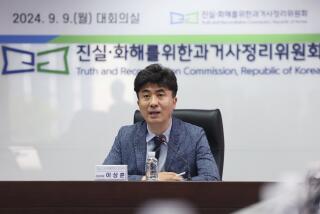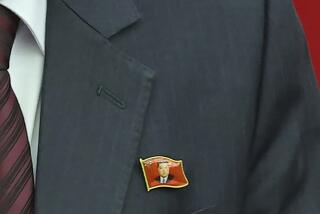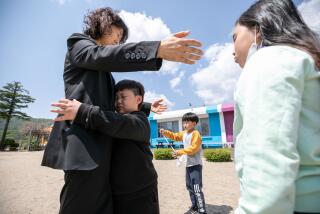North Korea-funded schools in Japan have an image problem
- Share via
Reporting from Tokyo — The portraits of North Korean leader Kim Jong Il have been taken down from the classrooms in the run-down Tokyo Chosen No. 2 Elementary School.
But a quick look into the teachers lounge reveals the Dear Leader in all his glory.
The school for ethnic Koreans in Japan, one of about 60 in the country that are funded by North Korea, faces a delicate balancing act as money from the reclusive regime has decreased amid economic turmoil there.
Since the 1950s, the schools have been run by the General Assn. of Korean Residents in Japan, or Chosen Soren, whose Tokyo headquarters acts as North Korea’s unofficial embassy.
At Chosen No. 2, the eight teachers and 54 students face a life of political isolation as they try to preserve their ethnic identity in Japan, a country many people believe is in the sights of North Korea’s nuclear missiles.
Former Principal Song Hyon-jin knows the school spreads what many Japanese consider communist propaganda. Activists have surrounded the school with megaphones shouting for students and teachers to leave the country, threats that increased after North Korea tested a nuclear device last year. A student at another Chosen school was accosted on the subway, her traditional hanbok robe, worn by many North Koreans, ripped by her attacker.
“Even though the Korean community has changed much in the past 20 years, it’s still tough to live as a Korean in Japan,” said Song, a longtime Chosen member.
The schools get no funding from the Japanese government, which doesn’t officially recognize them.
Song knows that loyalty to the schools is a complicated matter for Japan’s 1 million ethnic Koreans. Many of their ancestors immigrated here generations ago, before their homeland was divided into north and south after the 1950-53 Korean War. Some were forced to come as conscripts during Japan’s 1910-45 occupation of Korea.
Because there are no diplomatic ties between Tokyo and Pyongyang, the ethnic Koreans cannot apply for North Korean passports. They must be content to send their children to Chosen schools.
Since the 1970s, enrollment in the schools has fallen to less than 12,000 from 40,000, and fees have risen dramatically. In an effort to improve the schools’ image, administrators removed portraits of Kim Jong Il and his father, Kim Il Sung, from classrooms. They also added South Korean history to the curriculum, along with Japanese language and history.
Another change was softening the emphasis on North Korean propaganda, relying instead on a more straightforward history. To avoid undue attention, middle and high school students were ordered not to wear traditional Korean school uniforms after class.
“Schools have to be more open and acceptable for non-Chosen Soren affiliates for the sake of their existence,” said Han Young-hae, an associate professor at the Graduate School of International Studies at Seoul National University. “They need to reestablish their historical views and educational direction.”
As a result, the atmosphere here has lightened. South Korea also has begun taking up the financial slack, donating computers.
“I hope to teach here forever,” said Lee Young-sim, a 25-year-old art teacher who is a product of Chosen schools.
Song is heading a fundraising drive to build a new wing at the school, in hopes of stemming the defection of ethnic Koreans to Japanese schools.
“It is difficult to protect the school when many Korean kids are going to Japanese schools,” said Song, whose two children attend Chosen schools. “But I will do my best until the good day comes.”
Park is a special correspondent.
More to Read
Sign up for Essential California
The most important California stories and recommendations in your inbox every morning.
You may occasionally receive promotional content from the Los Angeles Times.













